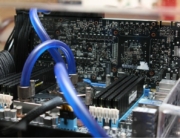Home / Handy Tips /
As gaming enthusiasts will know, today’s modern computer games require a setup that’s both fast and powerful to achieve the most immersive gaming experience. FPS vs refresh rate plays a pivotal role when it comes to creating the optimal gaming station.
Frames per second (also known as frame rate) and refresh rates are often confused, so this article will delve deeper into the two. Discover what they do, how they differ and how FPS and refresh rates can impact your gaming experience.
If you’re looking to tweak your current system or upgrade your hardware for more awesomeness, read on to discover more about FPS and refresh rates.
What is FPS (frames per second)?
Frames per second is a measurement of video frame rate. It’s most often used in the video game, TV and film industries. The frequency at which consecutive images are displayed on screen determines the number of frames per second. A jittery image is the result of a slow frame rate. Therefore, the faster the frame rate, the smoother the action is going to be.
This is very important when playing a video game, as a faster and smoother frame rate will deliver a far more immersive and enjoyable experience overall.
For film and TV, motion is created from a selection of still images being played consecutively, whereas FPS in a video game is the result of how quickly and smoothly the computer’s graphics processor renders the frames.
The frame rate needs to be consistent so the action never lags or speeds up. It’s also important that your gaming setup has a fast frame rate to handle fast-paced games. This renders the experience far more realistic.
FPS below 10 is too slow and anything above 60 frames per second is simply overkill, as the brain cannot differentiate anything above this figure.
Refresh rate of monitors explained
The measurement of the refresh rate of a computer monitor is in Hertz. Put simply, the refresh rate refers to how many times the screen can update the imagery every second. FPS in gaming determines the speed with which the graphics processor places images on the screen, whereas the refresh rate is how often the actual screen (monitor) refreshes the image.
On a 60Hz display, the screen can update every pixel 60 times per second. Likewise, a 144Hz display can update pixels 144 times per second.
A 60Hz display was the standard for TVs and computer monitors for many years but these days, a faster refresh rate for gaming provides a higher-quality display that enhances the gaming experience for both beginners and avid enthusiasts.
Both higher refresh rates and FPS are usually best for gaming.
Synchronisation between FPS and refresh rate
FPS and screen refresh rates are tied to each other. Upgrading one while neglecting the other is not a great idea, as screen tearing can be the result. This occurs when there is an imbalance between refresh rates and FPS.
When these two important display features are misaligned, you’ll likely see weird visual artifacts on your monitor while the game is in progress. It actually looks like the image is being torn. Screen tearing is both unsightly and distracting and definitely detracts from gaming enjoyment.
If you do have a disparity between FPS and refresh rates, there are some tools you can use to reduce or eliminate screen tearing.
- V-Sync: Embedded in the GPU, this technology is used as a setting to match up the computer graphics card’s frame rate with the refresh rate of your monitor.
- G-Sync: G-Sync employs variable refresh rate technology and is therefore able to match the monitor’s refresh rate with the graphics card’s frames per second rate.
- FreeSync: FreeSync basically works the same way as G-Sync and achieves the same result. With a variable refresh rate bringing the monitor into alignment with the FPS, screen tearing is often avoided.
What are the optimal settings for different genres of games?
While all types of computer games can certainly benefit from faster frame and refresh rates, games that operate at a rapid pace (first person shooters, for example) will be greatly enhanced by higher FPS and refresh rates. Ideally, for high-speed gaming, aim for 60fps and 144Hz for high performance and total enjoyment.
Story-driven games that operate at more sedate speeds don’t require high-speed FPS and refresh rates. 60Hz and 30fps are generally more than adequate for this style of gaming.
Some hardware considerations
You’ll need to upgrade your computer’s graphics card (GPU) if you want to achieve a higher frame rate (FPS) than what you already have.
To increase the refresh rate, you’ll need to upgrade to a monitor with a higher Hertz rating than what you’re currently using.
Your budget for upgrades will certainly come into consideration and you’ll need to balance both cost and performance when making your final decision. Talk to a computer expert for advice on the optimal setup for your needs.
Personalisation and preference
There is no one premium setup for computer gaming.
The best setup for you depends on your personal preferences, the types of computer games you regularly play and enjoy, and your budget for upgrading your equipment.
Ready to upgrade your gaming hardware?
Elevate your gaming experience with Computer Cures upgrade services. We can provide you with just the right graphics card and computer monitor to enhance your gaming needs and match your preferences.
Unlock the full potential of your computer gaming experience by getting in touch today. Discover how we can help you take your gaming to the next level.









Leave A Comment